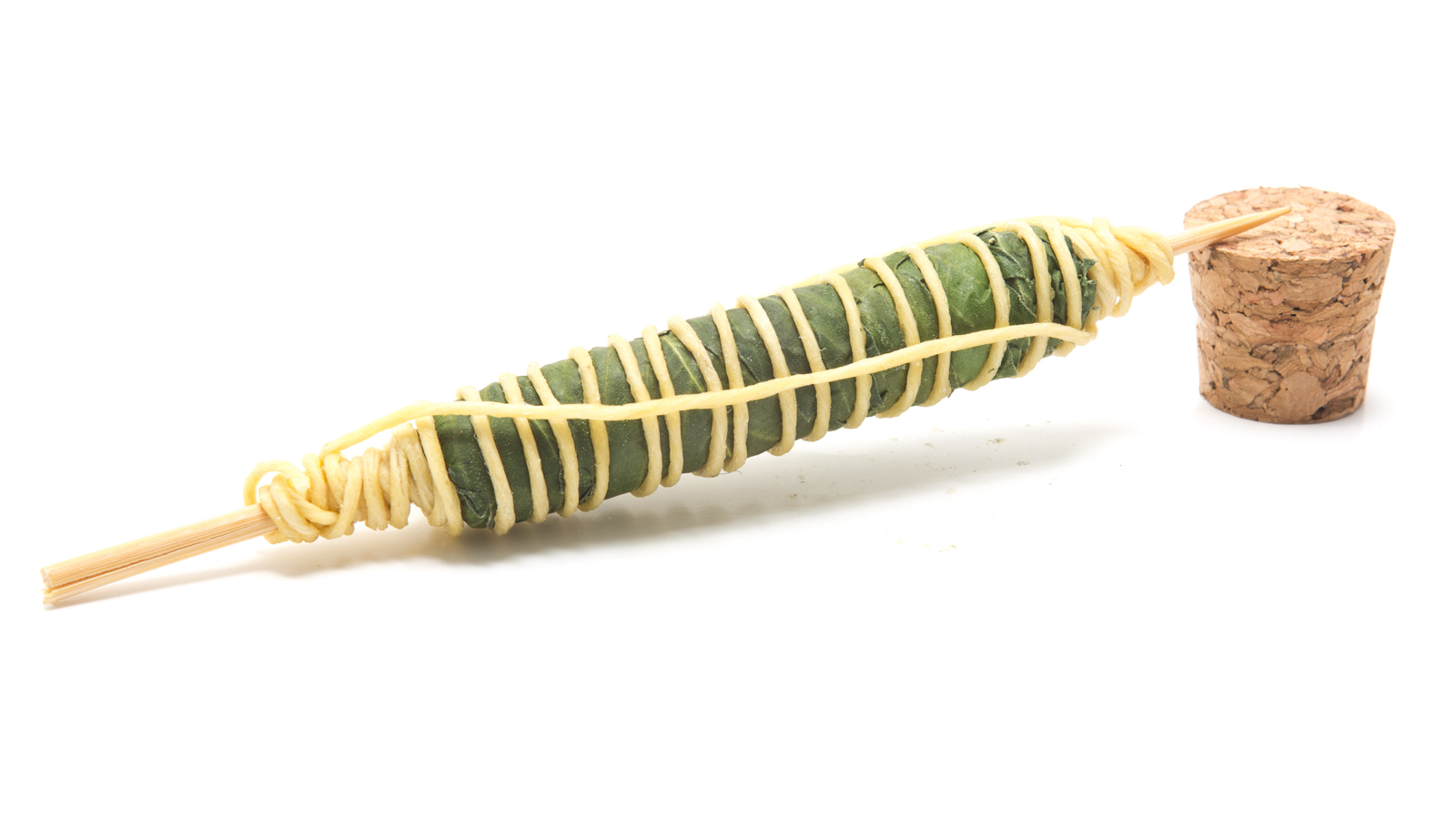An ancient form of a cannabis “cigar” deriving from Thailand, most popular in the United States in the 1970s. A Thai stick typically consists of cured flower skewered on a bamboo stick, wrapped in fan leaves and tied together with hemp string.
More about Thai sticks
In the modern age of cannabis legalization and product innovation, the luxury blunt or cannabis cigar has become a more prominent dispensary item in legal regions. But the modern canna-cigar's precursor, the Thai stick, is of ancient origin, and its basic form has barely changed since the days of its inception.
What is a Thai stick?
The construction of a Thai stick is, at its core, fairly simple and straightforward, though the smoking experience it provides may contrast significantly with that of a traditional joint or blunt.
 Photo by: Gina Coleman/Weedmaps
Photo by: Gina Coleman/WeedmapsImage lightbox

Most cannabis users will be familiar with the essential elements — long stocks of cured cannabis colas skewered or pressed around a bamboo stick, then wrapped in fan leaves. The Thai stick may also possibly be dipped in concentrate and/or sprinkled with kief. When the bamboo stick at the center is removed for smoking, the remaining hole in the center allows for sufficient airflow to properly burn the pressed flower, oil, and leaf wrap.
History of Thai sticks
Thai Sticks are an ancient creation of the hill tribes from northeast Thailand, though the exact timeframe of its origin remains unknown. It wasn't until the 1960s and '70s that the Thai stick made its way to the U.S. when American surfers and Vietnam War veterans started taking trips to Thailand and smuggling Thai sticks (possibly dipped in opium at times) into to the country.
The supply chain through which Thai sticks were smuggled to the U.S. fizzled out in the 1980s, and it wasn't until the current boom of the legalization market that these ancient canna-cigars made a comeback. Most online sources trace the modern Thai stick movement back to a mysterious cannabis connoisseur known as afgoo_head on Instagram.
Afgoo_head was reportedly the first to bring the Thai stick method into the modern age by crafting a variety of cannabis cigars that followed the same pattern. His modern Thai sticks eventually caught the attention of other aspiring cannabis cigar makers such as Roger Hinkley and Nathan Zeeb, co-founders of Artisan Kanna Cigars, who would then take the Thai stick concept and recraft it to make modern canna-cigars for the modern cannabis connoisseur.
How to make Thai sticks
The process of making a Thai stick is relatively simple, though it does require significant labor and hand-eye coordination. To make a Thai stick, you'll need some flower, a bamboo stick or chopstick, another small stick, some cannabis oil or concentrate, parchment paper, a refrigerator, a range, hemp string, and fan leaves for rolling.
First, coat your bamboo or chopstick in hash oil and press your bud around it, then wrap it with hemp string to hold it in place. Make sure you use the fluffiest buds at your disposal to optimize airflow for the end product. Once you've tied your stick up at both ends, wrap it in parchment paper and leave it in your refrigerator for a few days.
After a few days, unwrap the hemp string from your stick. The goal is to remove the string with the pressed bud fully intact around the stick. Then, coat the stick in hash oil and wrap it with washed fan leaves. Repeat coating and wrapping two more times for three layers of leaves around the stick.
Once you've finished your leaf wrapping, rewrap the Thai stick in parchment paper and briefly heat it in a pan on a low temperature for a few seconds. This will give the oil an opportunity to melt through all the layers and permeate the entire stick. Remove the parchment paper and re-wrap in hemp string, then seal the Thai stick in a plastic bag and put it in the fridge for up to a week.
Traditionally, Thai sticks are also buried to cure for up to three months. Once you've finished wrapping the leaves, you may also want to add an outer coating of oil or concentrate, as well as a coating of kief.
How to smoke a Thai stick
Thai sticks and canna-cigars may burn as slow as a quarter-inch per hour. They should be smoked in a similar fashion to a cigar, only with more inhale once the end is sufficiently lit. Using a torch may provide the optimal lighting, though Thai sticks can also be lit with a lighter or hempwick. Once the entire end is glowing red, you can start to inhale. Don't inhale while lighting because you'll essentially be inhaling the flame through the hole in the middle.
Modern Thai sticks
What's the difference between the traditional Thai stick and a modern-day canna-cigar? In short, not much. Whether you've seen them in a dispensary and seen them labeled as cannabis cigars, canna-cigars, or cannabis caviar, you're likely looking at some variation of the Thai stick. Rather than coat the Thai stick in opium, as the original creators might have done, most modern Thai stick makers opt for coating the cigar in high-quality concentrates and/or kief.

